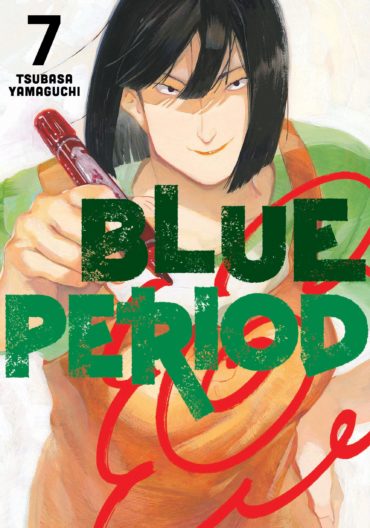Blue Period Volume 7 Review
Spoilers ahead – if you haven’t read Volumes 1-6, please don’t start here and check our previous Blue Period reviews instead!
“Now I’m not really sure why I’m making art.”
Yatora Yaguchi has gained a place at Tokyo University of Arts (TUA) on the Oil Painting Course – on his first attempt! It should all be plain sailing from now on… or so he hopes. After having to put on a suit and tame his hair with gel to look smart for the Opening Ceremony, it’s back to reality with a jolt. Also in his class is the prodigiously talented Yotasuke and he meets again Kinemi Miki, the girl who in the entrance exam, inadvertently broke his mirror (a happy accident, as it turned out). As the other students introduce themselves and their work, Yatora begins to feel intimidated by their high standards.
From the moment the three university instructors for the freshman course explain the first assignment, Yatora is all at sea. To be told that he must forget everything he ever learned (and he only just learned it!) is just not what he needs to hear. And to cap it all, the subject of the new assignment is yet another self-portrait – only this time they have a whole month in which to complete it. Meanwhile, in the faculty staffroom, the staff are discussing the new class, specifically the difficulties faced by those who got in on their second, third, fourth, fifth and even sixth attempts – and how hard it is for those students just out of high school (like Yatora).
The month drags. When things don’t go according to his plan, Yatora seeks out his friends from high school, hoping maybe that a night out drinking (like old times) will remind him who he really is and what he’s aiming for. Talking with Koi, now a trainee pâtissier, helps put things in context a little – but Yatora is suffering from Imposter Syndrome. “All right, I got in. Now what?”
It was never going to be plain sailing for Yatora – and even though the aspiring young artist thought he was ready to face whatever challenges TUA would throw at the first years, he finds himself totally lost. If you’ve ever been on an arts course of any kind, you’ll find yourself empathizing with Yatora’s predicament and feeling his pain. It’s really hard to watch his growing desperation as he battles with the assignment, trying to discover what he needs within himself to make a piece of art that fits the brief but shows a completely different approach and completely different skills from his examination pieces. This is where Tsubasa Yamaguchi’s talents as a mangaka really shine. Many mangaka would probably have shuttled swiftly through Yatora’s self-doubts, wanting to move his story along at a brisker pace. But the story is Yatora’s growth as a person and an artist (and also that of his fellow art students) and because Yamaguchi-sensei delves into this in detail, the result is a valuable and insightful exploration of what it means to learn to become an artist.
We’re straight into post-anime TV series territory with this volume, so it’s fascinating if you’ve become invested in this series to see what becomes of the characters next. It’s good to find Yatora running unexpectedly into fellow prep school student Kuwana as the last time we saw her, she was off to a rock concert with her sister to try to get over her disappointment at not being offered a place (like everyone else in her family) at TUA. Being the kind of girl she is, there’ll be no easy answers for her as she tries to figure out what to do next – but there are some surprises in store by the end of this volume. (And good to see Ooba-sensei on hand to give typically unconventional yet appropriate advice!)
Translation for Volume 7 for Kodansha is again by Ajani Oloye and they continue to provide a very readable English version including all the technical terms. Only two translation notes at the end this time and four 4-koma strips about new characters.
As Blue Period starts a new story arc, Tsubasa Yamaguchi explores the vital question: ‘can creativity be taught?’ through Yatora’s experiences. It doesn’t sound as if it’s going to grab the attention, but thanks to Yamaguchi’s storytelling, engaging characters and quirky approach, it makes for vivid reading. Don’t skip this volume!


